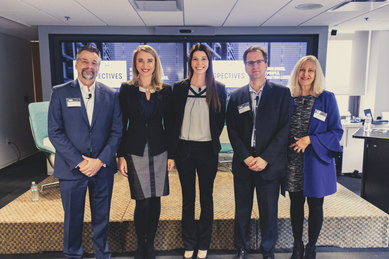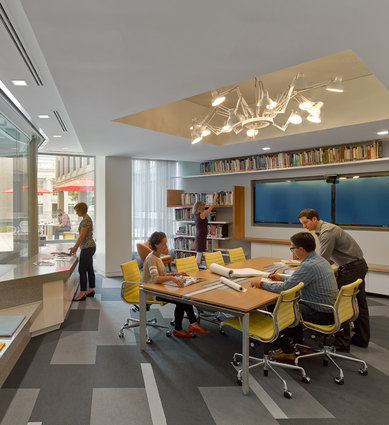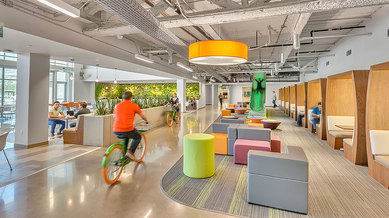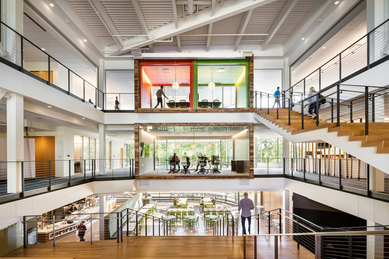Healthy Buildings. Healthy People. Healthy Bottom Lines.
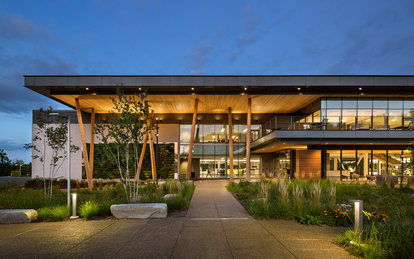
As companies compete to attract and retain top talent, workplace design can play a role in an organization's success. More importantly, a workplace environment can lead to increased employee well-being, improved cognitive function, fewer negative health symptoms, increased productivity, reduced absenteeism, and healthier bottom lines. In 2019, SmithGroup's Workplace Practice hosted a Perspectives panel discussion highlighting how high-performing buildings and corporate culture can lead to a healthier, happier, more productive workplace. The following post gives readers insight into the group's discussions on this topic.
In March of 2019, SmithGroup had the pleasure of hosting a panel discussion on a topic that is relevant and crucial to many of our clients: creating healthy workplaces. As the Workplace Studio Leader in our Detroit office, I was joined by (left to right) Dr. Whitney Austin Gray from Delos, Candice Messing from General Motors, and David Slavney from Mercer MMC. My colleague Lise Newman, Workplace Practice Director at SmithGroup, served as the event moderator.
Personally, my passion for this subject area stems from a career-long interest in sustainable development. Historically, I’d thought about sustainable development in terms of minimizing a project’s impact on the natural environment and reducing its carbon footprint. Then a few years ago, an article published by the Rocky Mountain Institute changed my perception because it emphasized the importance of people-focused metrics when renovating a space. This idea has since revolutionized my personal practice, including how I approach projects and clients. Our latest Perspectives Panel—Healthy Buildings. Healthy People. Healthy Bottom Lines—sought an engaging discussion on the topic. Some key themes emerged:
Design environments that foster health and well-being.
For many years, building owners and designers did not give much consideration to how a workspace impacted employees’ physical or emotional well-being. Today, the conversation has changed. Future-focused organizations understand that healthier work environments can lead to improved cognitive function, fewer negative health symptoms, increased engagement and productivity, and reduced absenteeism—all of which work together to improve a company’s bottom line.
As we set out to create environments that help organizations achieve these goals, it is important to consider a concept called biophilia—a human’s need for connection to nature. Both Dr. Gray and I discussed the ways in which biophilic design elements can positively impact building occupants. For instance, exposure to natural daylight can help to stabilize an individual’s biorhythms, which leads to a more restful night’s sleep and lower levels of stress. We also expressed a shared belief that designers have a responsibility to incorporate biophilic design elements into the spaces they create. Solutions could include a range of considerations, such as providing employees access to daylight and views to the outside; installing mechanical systems that infuse spaces with fresh air; or offering staff access to healthy food, fresh water, outdoor amenities, and more. These alterations may seem simple, but they can reap huge benefits both in and out of the workplace.
Design for movement and choice.
As the discussion around what it means to create a healthy workplace continues to evolve, one aspect that we often overlook but that needs further consideration is human physiology. Humankind evolved as hunter-gatherers on the Serengeti, not sitting at desks in high-rises in Manhattan or Detroit. It’s important to consider the larger environmental context when discussing human physiology and biophilia. In addition to looking for opportunities to connect employees with nature, designers can also make choices that encourage employees to get out of their chairs and incorporate some physical movement throughout their day. An effective idea is the integration of a communicating stair that connects all floors of an office and encouraging employees to walk instead of taking the elevator.
Another relatively simple way to improve employee well-being is to put choice at the forefront. Both David Slavney and Candice Messing discussed at length how, especially with Millennials in the workforce, having the freedom to choose where and how they work has become a paramount factor that candidates weigh when considering a job opportunity. For example, at General Motors, Candice explained that during the course of their workplace transformation, they created eight unique types of work settings. These range from social, collaborative areas like a work café to designated quiet spots where employees can have uninterrupted, focused time.
Leadership must foster a healthy culture.
Something I firmly believe is the importance of leading by example. As social creatures, we learn through interactions with our peers, and in the office, we’re bound to take cues from what our leaders are doing. And the leaders aren’t just CEOs and supervisors; we all have a responsibility to ourselves and to our coworkers to act as leaders, especially in the context of making healthy decisions at work.
Take time to “un-focus.”
During the panel conversation, Dr. Gray made the compelling statement that innovative and inspiring “Aha!” moments don’t come when people are diligently focusing—they come when we are showering, working out, playing with our children, or falling asleep at night. With this in mind, organizations would benefit from incorporating what my colleagues and I call “un-focus spaces” into workplaces, places where employees can go play a game of foosball or take a walk for ten minutes to clear their heads. In today’s corporate environment, where productivity is stressed above all else, we need to create a culture in which “unfocused time” is encouraged, not only as okay, but as beneficial to our well-being and ability to innovate. The next time you see colleagues taking a break, don’t shame them—join them.
Creating a healthy workplace is a worthwhile investment for your business.
“What is this going to cost me?” is a phrase that I hear in every client conversation about workplace transformation. Here are some notions I try to convey to ease clients’ concerns:
- 90% of the cost of running a business is in the people, only 10% is in real estate and construction
- Investing in people has a rapid return on investment
The Rocky Mountain Institute found that while the return on investment of a retrofit specifically for sustainability reasons can be as much as 15 to 20 years, the return on investment of a retrofit targeting employee health and happiness can be much shorter; even as little as a couple of years. Think about this: if employees are happier and healthier, they will take fewer sick days, they are more likely to stay at a company for a longer period of time, and they will likely perform more efficiently when they are at work—all of which cut costs in the long run. If we think about how much money our nation spends on real estate and health, two of the biggest industries in the country, what would happen if those two industries came together to achieve common goals? The results would be phenomenal.
Full Circle
Incidentally enough, this conversation comes at the perfect time for us here in the Motor City, as SmithGroup’s Detroit office prepares to embark on an office transformation of its own. Through our robust workplace design strategy process, we have examined the kind of behaviors that we want to support in this space, and we have thought about the different work settings we want to offer our employees. We are being very deliberate about where we place shared amenities, choosing to put them in areas that nudge employees to healthier behaviors, abandoning sedentary habits and increasing movement. We also seek to provide better access to natural light and fresh air, more democratic access to window walls, and a complete redesign of our outdated mechanical systems. Our most dramatic move will be blasting out the slab between our floors to create a communicating stair, which will encourage both social interaction and physical activity. Since we spend so much time talking to our clients about the benefits of a healthy workplace, it feels good to follow the advice that we give to them and invest in our most valuable asset—our own team members.

